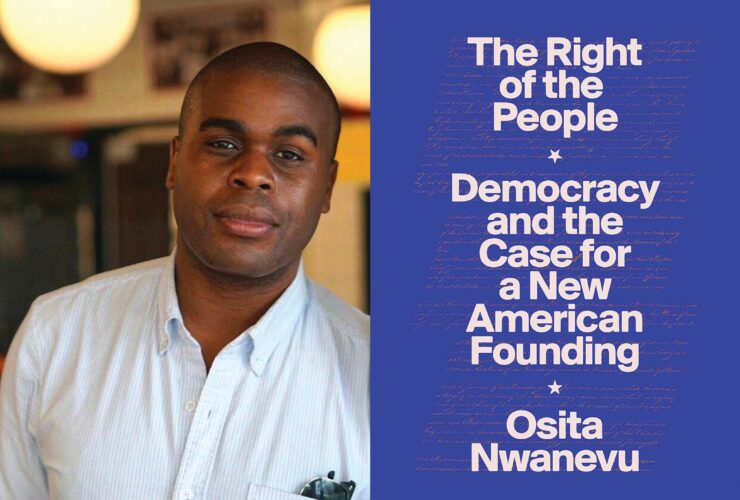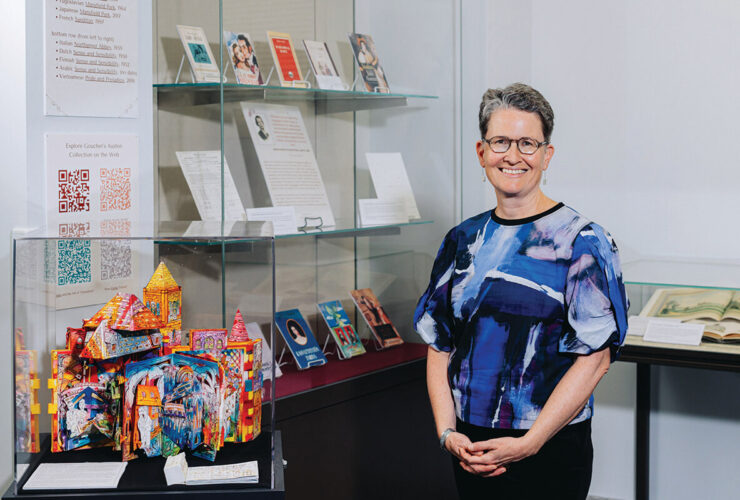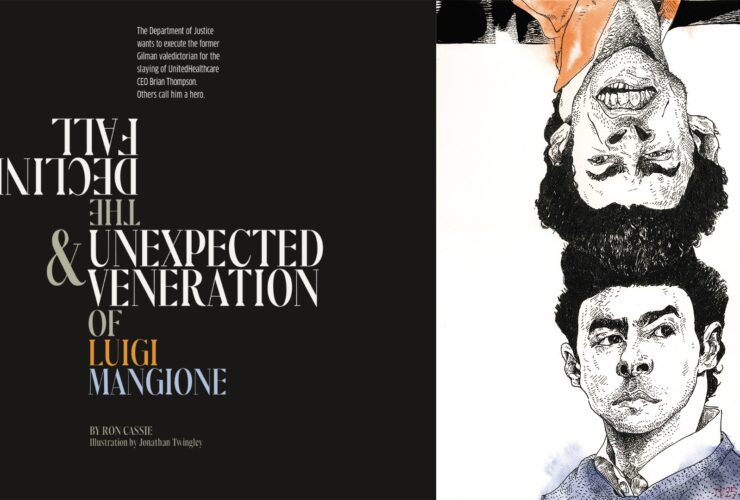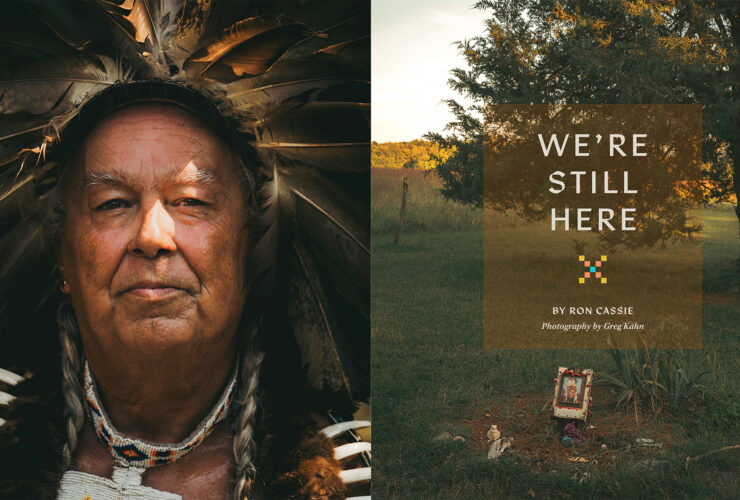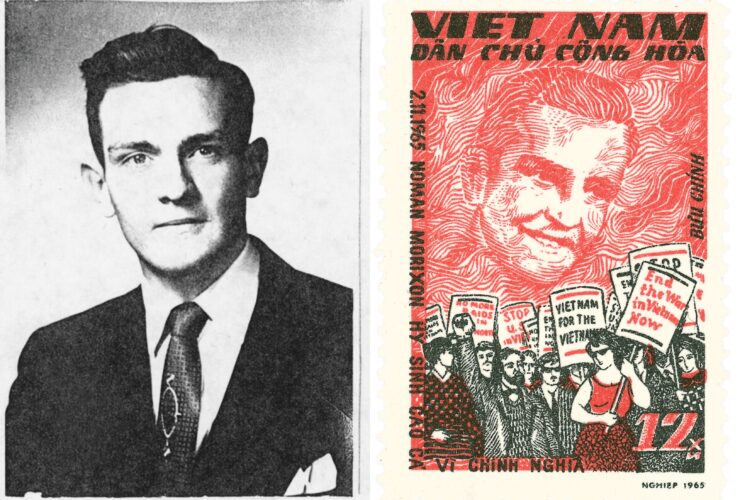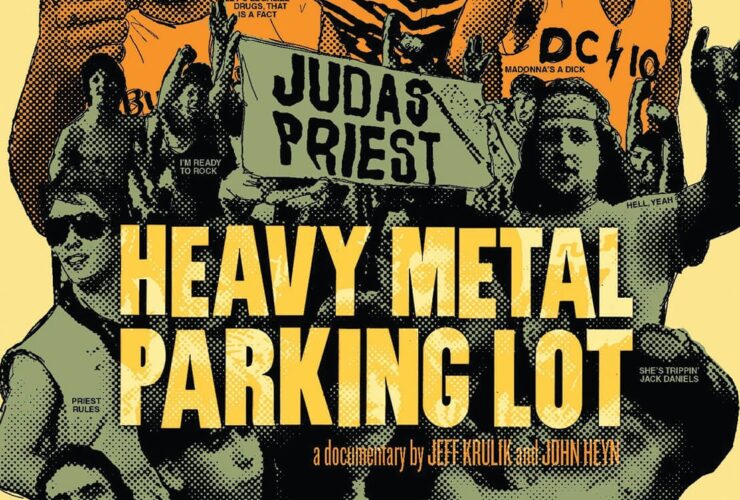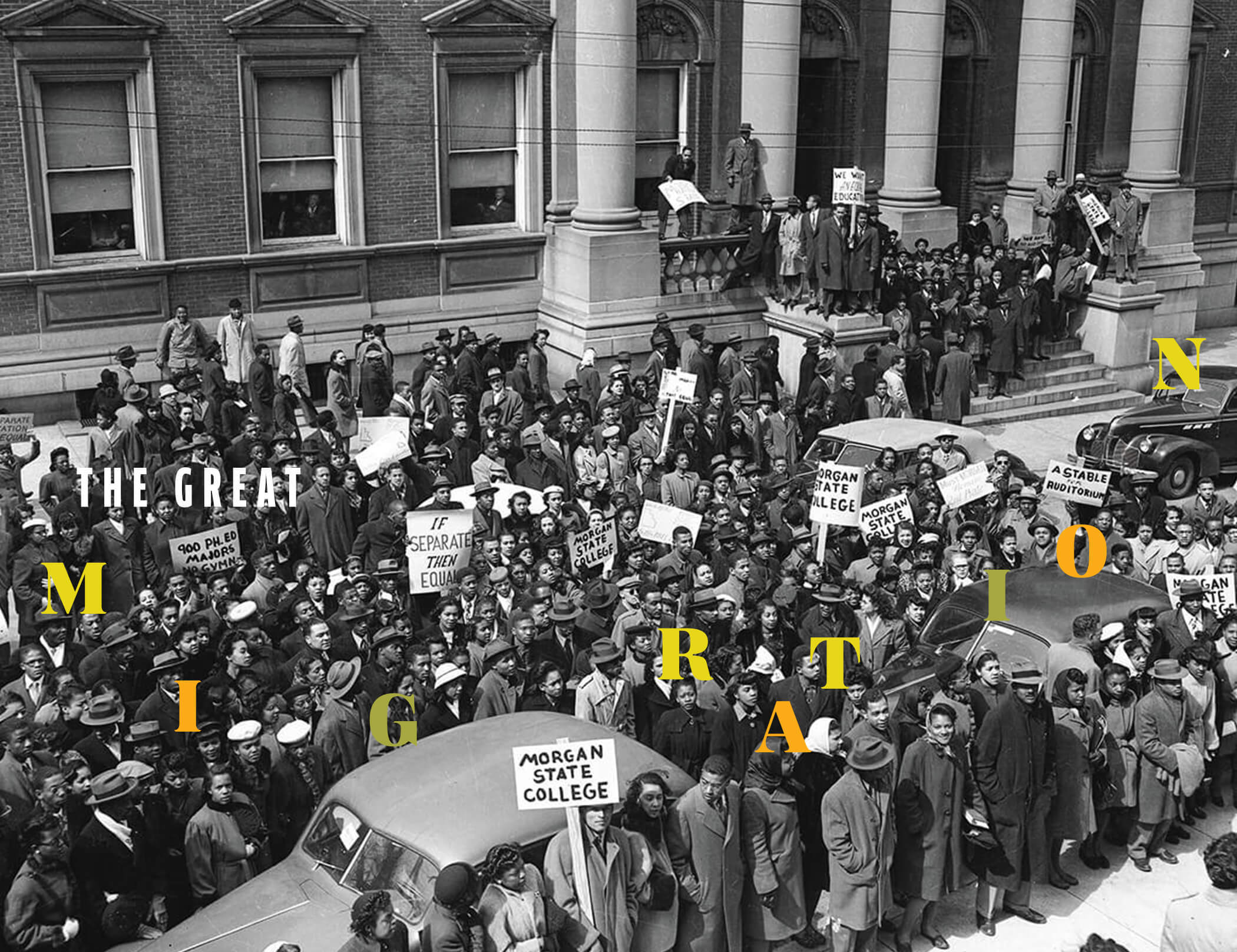
History & Politics
The Great Migration
How Black families came “up South,” faced down Jim Crow, and built a groundbreaking Civil Rights movement.
By Ron Cassie

JACOB LOGAN SAW AN OPPORTUNITY. It was 1945, and Cherry Hill was finally being developed to alleviate housing shortages for the Black veterans and World War II defense workers that had flooded into Baltimore.
After years of delays because of white backlash at other proposed sites, the Cherry Hill project—the first suburban-style planned community for African Americans, and perhaps most conspicuous example of residential segregation by design ever in the United States—went up quickly once it got the go-ahead. Families rushed into the new rowhouses and apartment buildings before basic infrastructure, such as a school, shopping center, or grocery store, were even in place.
Originally from the rural South, Logan worked at the Bethlehem-Fairfield docks, having come to Baltimore during the war to build Liberty ships. Despite a fifth-grade education, he’d also managed to save and invest in a small corner grocery in a nearby Black section of South Baltimore by the time construction in Cherry Hill began. His wife, Estelle, a former downtown elevator operator, ran the store during the day while he toiled at his union job at the port. She was also from North Carolina, but they’d met in Baltimore.
In a moment of inspiration, the 25-year-old Logan purchased a used delivery truck when Cherry Hill opened its doors. Cramming the vehicle with every foodstuff, household, and drug store item he could buy or get on credit, he started making two Cherry Hill runs a day in his mini-Walmart on wheels. He drove through once in the morning, and then again after the neighborhood kids had returned from school. Later, he replaced the truck with an old, but bigger, school bus. “Oh, my God, how I remember,” recalls Linda Morris, author of Cherry Hill: Raising Successful Black Children in Jim Crow Baltimore. “We’d chase down the street after the bus: ‘Mister Logan, Mister Logan, do you have penny candy? Do you have penny candy today?’”
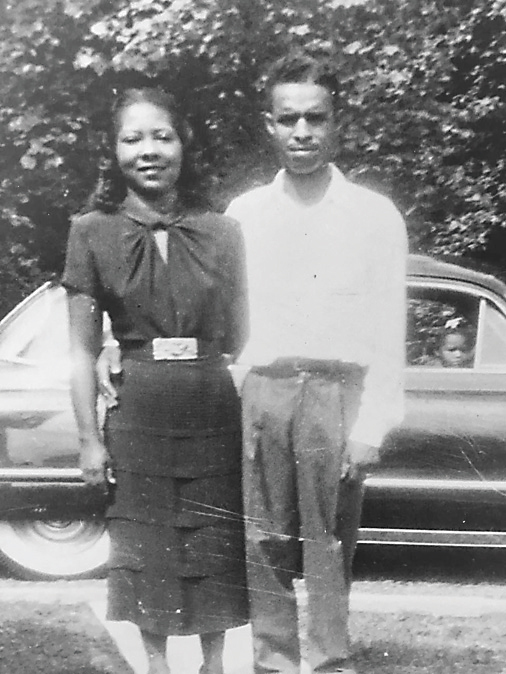
Estelle and Jacob Logan in front of the family car, late 1950s.
Born in 1920, Logan had grown up in the western corner of North Carolina, in Rutherford County, so named for a local plantation slaveholder and former U.S. Army general who had made his mark in the southern Appalachian “Indian” wars. Logan was raised on his grandparents’ farm, where he worked as a boy until he left home and school at 12 for domestic employment with a white family in nearby Forest City—coincidentally the site of one of the state’s most notorious lynchings—for room, board, and $1 a week. Three years later, with scant prospects in his state of origin, he left all he knew behind to earn $10 a week as a houseman for another white family in New York. He bolted to Baltimore after learning of higher wages building ships in the war effort.
Eventually, Logan would leave his Bethlehem-Fairfield job, too, opening a second grocery store in Turner Station, the then-fast-growing Black community in southeast Baltimore County. Building on his entrepreneurial successes, he launched a popular bread company in the 1950s, plastering his visage on loaves of “Daddy Logan” bread. When he retired at 73, he took up golf, which he’d dreamt of playing since his teenage caddying days.
“When the white businessman he worked for in New York told him he’d never be able to learn the game because he was Black—he would’ve said Negro or Colored in those days—my father never forgot that moment,” recalls Logan’s daughter, Francesca Brooks. “He played every day after he retired at Baltimore’s public courses and everywhere else. In his 80s, he’d challenge anyone to play him for money. His last golf trip, he took his son-in-law with him back to North Carolina, to play Pinehurst [the famous, long-segregated professional course]. That meant everything to him because of its history. He was 95. That was his bucket list. He died two years later in 2017. Only once did I hear him express anything like regret or bitterness. I guess he kept those thoughts and feelings from us. ‘I made it a long way in my lifetime,’ he said. ‘I just would’ve liked to have seen how far I could’ve gotten, if I hadn’t started so far behind.’”
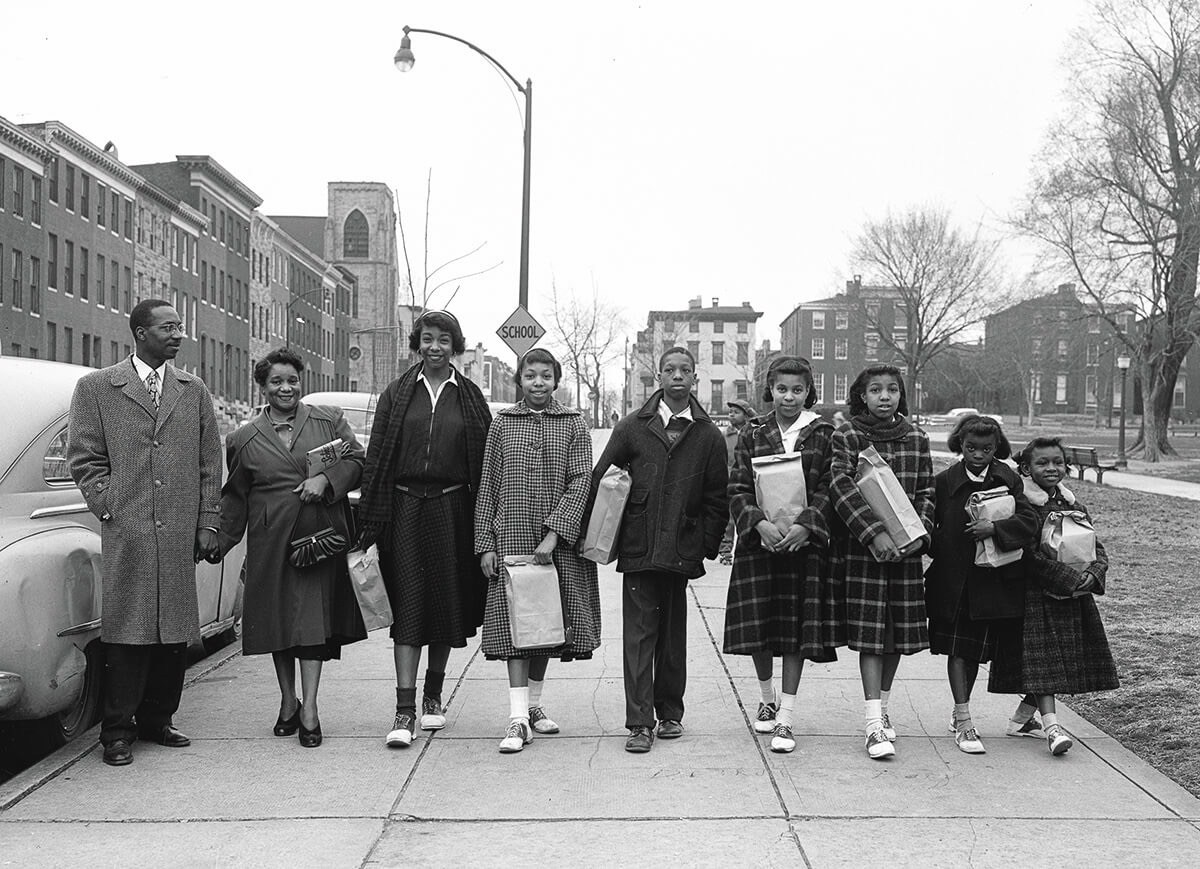
The Dean family buying their Easter shoes. From left, Walter, Ruth, Annette, Patricia, Ransom, Delores, Sonia, Gloria, and Janice.
“I was leaving the South to fling myself into the unknown . . . I was taking a part of the South to transplant in alien soil, to see if it could grow differently, if it could drink of new and cool rains, bend in strange winds, respond to the warmth of other suns and, perhaps, to bloom.”
—Richard Wright, from Black Boy, 1945
The Great Migration, the exodus of more than 6 million African Americans from the rural South to cities in the North—or in Baltimore’s case, almost North—Midwest, and West between 1910 and 1970, was one of the largest internal movements of people in U.S. history. It also remains, with the exception of Isabel Wilkerson’s award-winning treatise, The Warmth of Other Suns,whose title honors the Mississippi-born Wright, one of the most under-chronicled stories of the 20th century.
In each U.S. Census prior to 1910, more than 90 percent of the country’s Black population lived in the South, with the overwhelming majority of those individuals spread out in rural areas across former Confederate States. By the end of the Great Migration, nearly half of the nation’s Black population had decamped for the booming cities of Detroit, Chicago, New York, and Philadelphia, and Cleveland, Newark, Pittsburgh, and “Up-South” Baltimore, to name a few, in hopes of economic opportunity, education, relief from white oppression and violence, and something closer to full participation in the civic life of their own country.
Without this leaderless mass flight— “Oftentimes, just to go away is one of the most aggressive things that another person can do,” wrote John Dollard, an anthropologist studying the racial caste system of the South in the 1930s—there would be no successful World War II defense build-up at Sparrows Point, the Bethlehem-Fairfield shipyards, or the huge Glenn L. Martin aircraft plant in Baltimore. There would be no Steel Belt, no “Big Three” auto-making capital in Detroit, no “City of Big Shoulders” meatpacking houses and railroad yards. Which means there would also be no Motown, no Chicago blues, no Muddy Waters, no Aretha Franklin, and no Jackson 5. There’d be no Harlem Renaissance, Langston Hughes, and Zora Neale Hurston—a Florida native who attended high school in Baltimore. There’d be no modern jazz as we know it. Thelonius Monk and John Coltrane were born less than a decade apart in rural North Carolina—just like Jacob Logan.
In Baltimore, the proportion of the Black population tripled during the Great Migration, growing from less than 85,000, 15 percent of the city’s overall population, in 1910, to more than 420,000 and a near majority by 1970. As it is impossible to imagine this country without the contributions of those who fled the Deep South for Detroit, Chicago, and New York, it’s impossible to conjure a Baltimore without the hundreds of thousands of people who came to the city as part of the Great Migration—whether under their own volition or carried to new futures by their parents.
A few notables: the late U.S. Rep. Elijah Cummings, the son of former South Carolina sharecroppers; Judge Robert Bell, retired Chief Judge of the Maryland Court of Appeals, who returned home to North Carolina during his boyhood summers to tie and cure tobacco; former state Sen. Clarence Blount, also the son of Carolina tobacco workers and the first African-American majority leader in the General Assembly; former state Sen. Verda Welcome, one of 16 children raised on a small North Carolina farm and the first Black woman ever elected to a U.S. state Senate; former city councilwoman and homeless advocate Bea Gaddy; acclaimed poet Lucille Clifton, twice a finalist for the Pulitzer Prize; and renowned singer Ethel Ennis, Baltimore’s “first lady of jazz,” who died a year ago this month. Her parents, a Harlem Park barber and a homemaker who played piano at Ames United Methodist Church, both migrated from South Carolina and met in Baltimore.
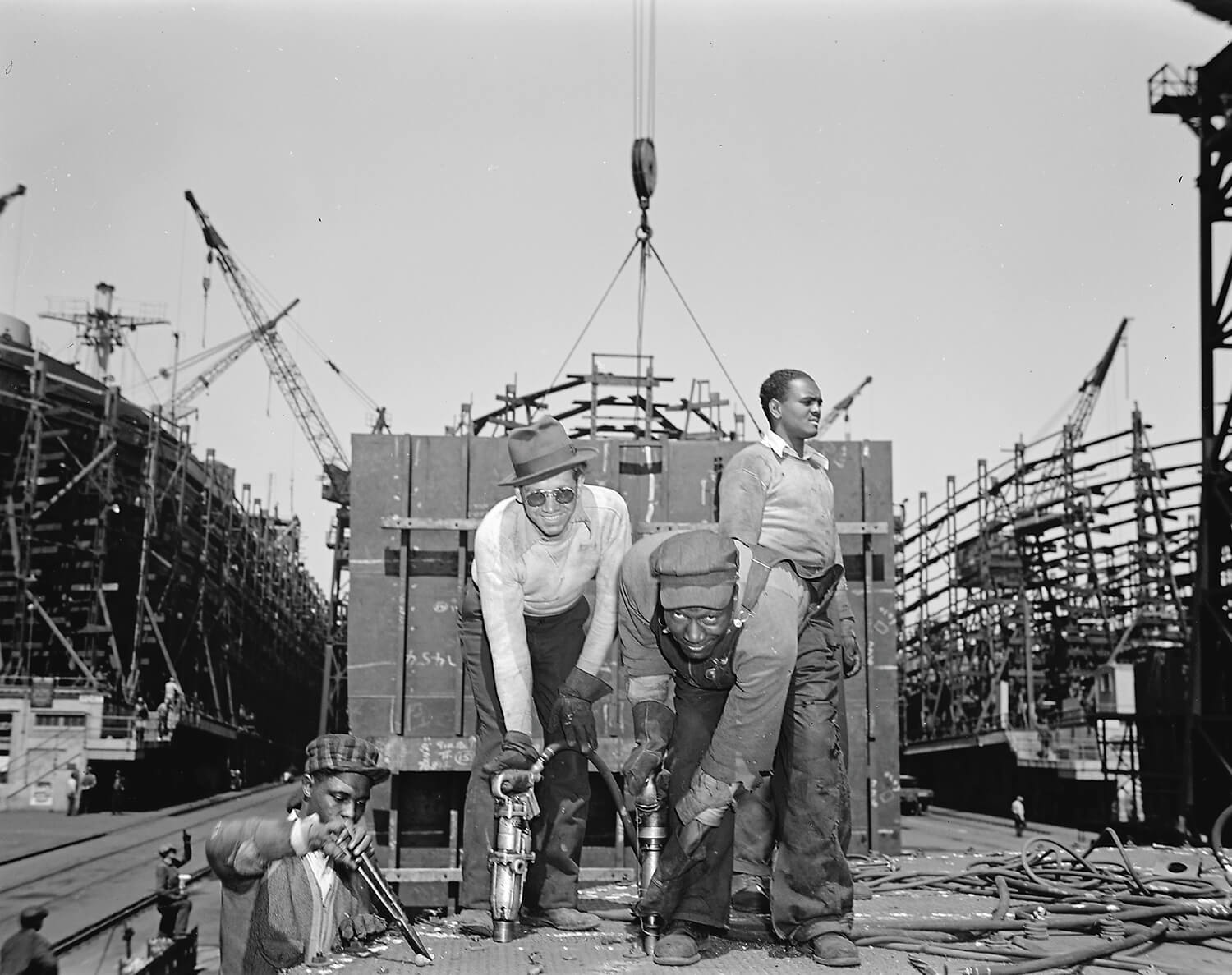
Above and Below: More than 6,000 Black male and female workers were employed at the Bethlehem-Fairfield shipyards, where Liberty ships, including the SS Frederick Douglass, were rushed to completion, May 1943.
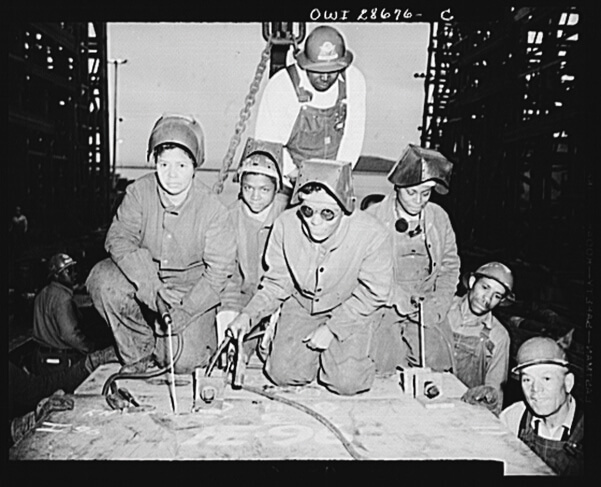
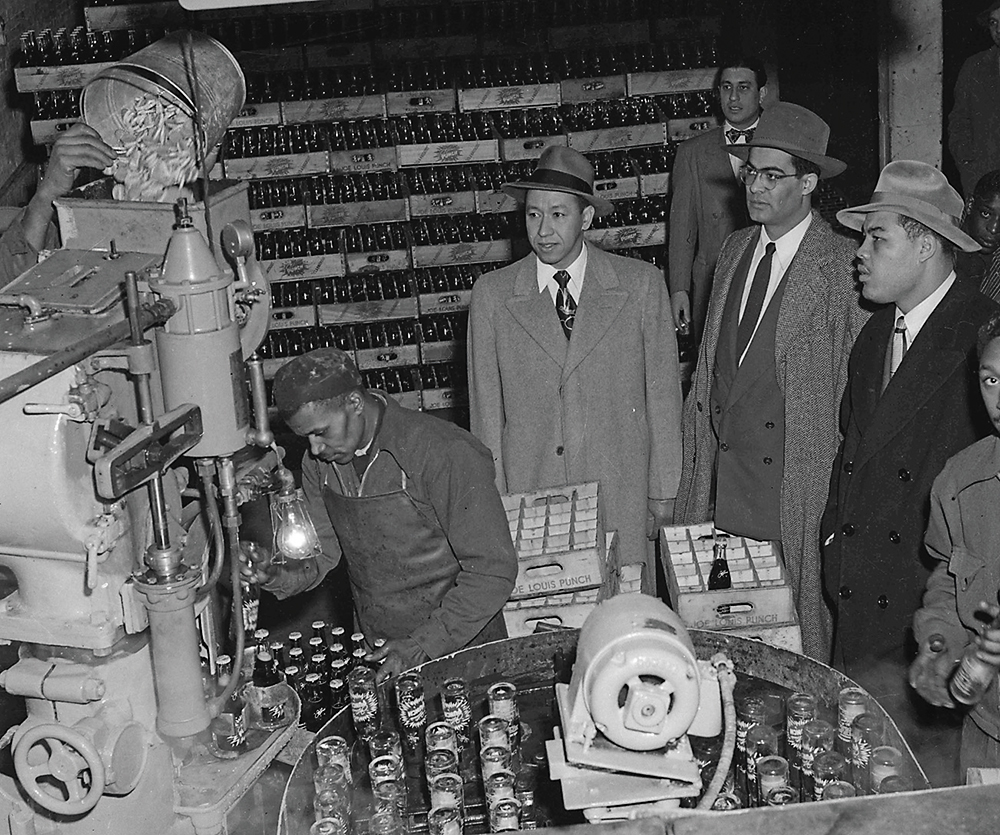
Willie Adams, Henry Parks, and Joe Louis (in hats, from left) at Louis’ bottling company in West Baltimore.
Businessman, investor, and subsequent political power player “Little Willie” Adams left the cotton fields of Zebulon, North Carolina, in 1929 at 15. A literal rags-to-riches story, Adams worked his way up from running numbers and cutting sailcloth into rags at a Fells Point shop to running his own illegal lottery operation, among other business. Later, he emerged to use his influence, wealth, and resources to finance scores of legal Black businesses, including the Super Pride grocery chain and Parks Sausage Co., one of the first Black-owned companies to trade publicly on Wall Street.
At the same time, William March, born to a North Carolina Lutheran minister following the flock to Baltimore, clerked a post office night shift while building his eastside funeral business into one of the largest African-American-owned mortuary services in the country. March would also co-found the Harbor Bank of Maryland, the state’s first Black-owned commercial bank. And before all that, Master Sergeant March participated in the 1944 D-Day landing at Normandy.
Negro League star Leon Day was born in Virginia, moved to Baltimore with his family as a youngster, and ended up in the Hall of Fame in Cooperstown. A generation after Olympian Jesse Owens, heavyweight champion Joe Louis, and Brooklyn Dodger Jackie Robinson made their marks—all children of sharecroppers who made their way North or West as part of the Great Migration—Jim Parker and Gene “Big Daddy” Lipscomb, born in Georgia and Alabama, respectively, came to Baltimore and helped the Colts win two NFL titles. Orioles’ great Frank Robinson, as well as standout Don Buford, both born in Texas in the 1930s, helped the O’s become the best team in baseball. Earl “the Pearl” Monroe and Wes Unseld, drafted back-to-back in 1967 and 1968, came with roots in Kentucky and North Carolina, respectively, and made the Bullets the most exciting team in professional basketball.
The parents of Kurt Schmoke, the city’s first elected Black mayor, are from North Carolina and Georgia and met here.
Quiltmaker Elizabeth Talford Scott, a middle child of 14, whose family sharecropped vegetables and cotton on the land where they once had been enslaved, made the Great Migration journey from rural South Carolina to Sandtown-Winchester in the late 1930s. She worked as a housekeeper and nanny and eventually met Charlie Scott Jr., a Bethlehem Steel crane operator and son of North Carolina tobacco sharecroppers. Their daughter is MacArthur “Genius” Grant winner and artist Joyce J. Scott.
“My parents left the South in order to get jobs that weren’t back-breaking and to join other family who had already left,” says Scott, whose mother died in 2011. “My mother came to Washington, D.C., first. She was on her way to Chicago, and Baltimore was supposed to be a way station. Then she met my father. My mother went to a one-room schoolhouse, and my father, the same thing. They left to get away from the persistent and overt racism that happened every day. They told stories of being afraid of the police, of people arrested for loitering and being put in jail without a trial or put on a chain gang for weeks, months, and years to work on some white farmer’s land. Those things [related to a penal labor practice known as “convict leasing”] are not myths. That was prevalent.
“There were so many people in West Baltimore from Virginia, North Carolina, and South Carolina—there were whole communities and congregations that were like ‘Little Virginia,’ ‘Little North Carolina,’ and ‘Little South Carolina,’” continues Scott, who attended since-closed, once all-white Eastern High School during the mid-1960s civil rights era. “They helped people from the country adapt to the city.”
Joyce J. Scott and Elizabeth Talford Scott’s joint exhibition last year at The Baltimore Museum of Art, Hitching Their Dreams to Untamed Stars, evoked both the Underground Railroad and “over-ground” Great Migration. “Those exoduses are cousins,” Scott says. One of her mother’s quilts in the show, “Plantation,” features a galaxy of multicolored stars in the night sky, referencing both the land where she grew up and the constellation maps enslaved people used to escape to the North.
“What seems of most interest here is that they were in the frame of mind for leaving,” the Black scholar Emmett J. Scott (no relation to Joyce J. Scott or Elizabeth Talford Scott) wrote in 1920 of the first Great Migration wave, kickstarted by labor shortages in the North as European immigration came to an abrupt halt during World War I. “They left as though they were fleeing some curse; they were willing to make almost any sacrifice to obtain a railroad ticket and they left with the intention of staying.”
This flight from the Deep South, continued Emmett J. Scott, whose papers are archived at Morgan State University, suggested nothing short of the Israelites’ decision to flee Egypt and cross the Jordan River for the Promised Land. “At times, demonstrations took on a rather spectacular aspect, as when a party of 147 from Hattiesburg, Mississippi, while crossing the Ohio River, held solemn ceremonies,” he reported. “These migrants knelt down and prayed; the men stopped their watches and, amid tears of joy, sang the familiar songs of deliverance . . . One woman of the party declared that she could detect an actual difference in the atmosphere beyond the Ohio River, explaining that it was much lighter and that she could get her breath more easily.”
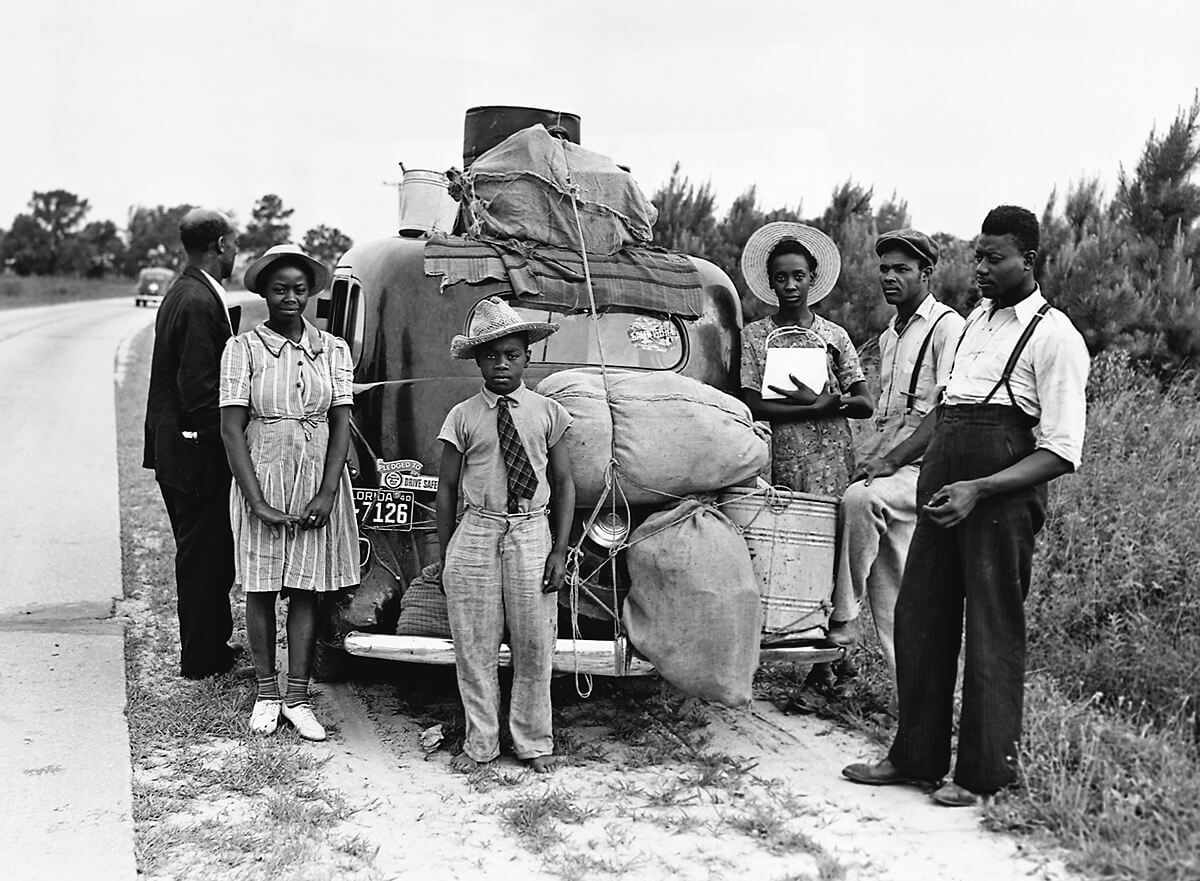
A family of migrant workers from Florida stop alongside the road in Sawboro, North Carolina, on their way north, July 1940.
At first, Great Migration arrivals into Baltimore were mostly in-state transplants, as one might expect, from Eastern Shore sharecropping farms and Southern Maryland tobacco fields. In 1910, 87 percent of the city’s Black population was native to Maryland, with migrants from Virginia making up the largest group of those born outside of the state. By 1920, however, the share of Black Baltimoreans who were Maryland natives had already declined to 76 percent. By the outset of the Great Depression, nearly half of the city’s Black population had been born outside Maryland.
The early in-state migrants were lured up and across the Chesapeake Bay by the already large and, in many cases, thriving Black neighborhoods in East and West Baltimore that had been built around Black churches, Black-owned businesses, then-Morgan College, and the city’s burgeoning mill, railroad, factory, and port industries. Since at least Frederick Douglass’ time in the city in the 1830s, African Americans from the Eastern Shore and Southern Maryland had viewed Baltimore as a kind of mecca. After the Civil War and brief optimism of Reconstruction, they continued to come seeking better jobs and wages and education for their children.
Equally important: those leaving Maryland’s rural counties for Baltimore were also seeking relief from discrimination and political oppression, as well as the ever-present threat of white violence—they were, for all intents and purposes, refugees seeking asylum within the borders of their own state. Baltimore was still segregated, but it provided greater opportunity and options, and it was safer. From 1877 to 1950, more than 4,000 Black Americans, an average of more than one person a week, were lynched in the U.S. The last three of the more than 40 lynchings that took place in Maryland occurred in the early 1930s on the Eastern Shore, later than commonly assumed, and still within the lifetime of many Maryland residents today. But no lynching, as far as anyone knows, ever took place in Baltimore City, where there had always been a large, free, dynamic Black population.
Such was the terror inspired by lynchings and near-lynchings, according to Charles Chavis Jr., director of the John Mitchell Jr. Program for History, Justice, and Race at George Mason University, that there was a direct correlation between those witnessing lynchings on the Eastern Shore and those fleeing to Philadelphia and Baltimore. “In terms of the Eastern Shore and its sense of place, with its agriculture and isolation, it possessed the spirit of the antebellum Deep South,” says Chavis. “The whole concept of Maryland as ‘the Middle Ground’ with both a history of slavery and also always a large free Black population in Baltimore makes it unique in the story of the Great Migration. Baltimore wasn’t the ‘North,’ but for many, it was ‘close enough.’”
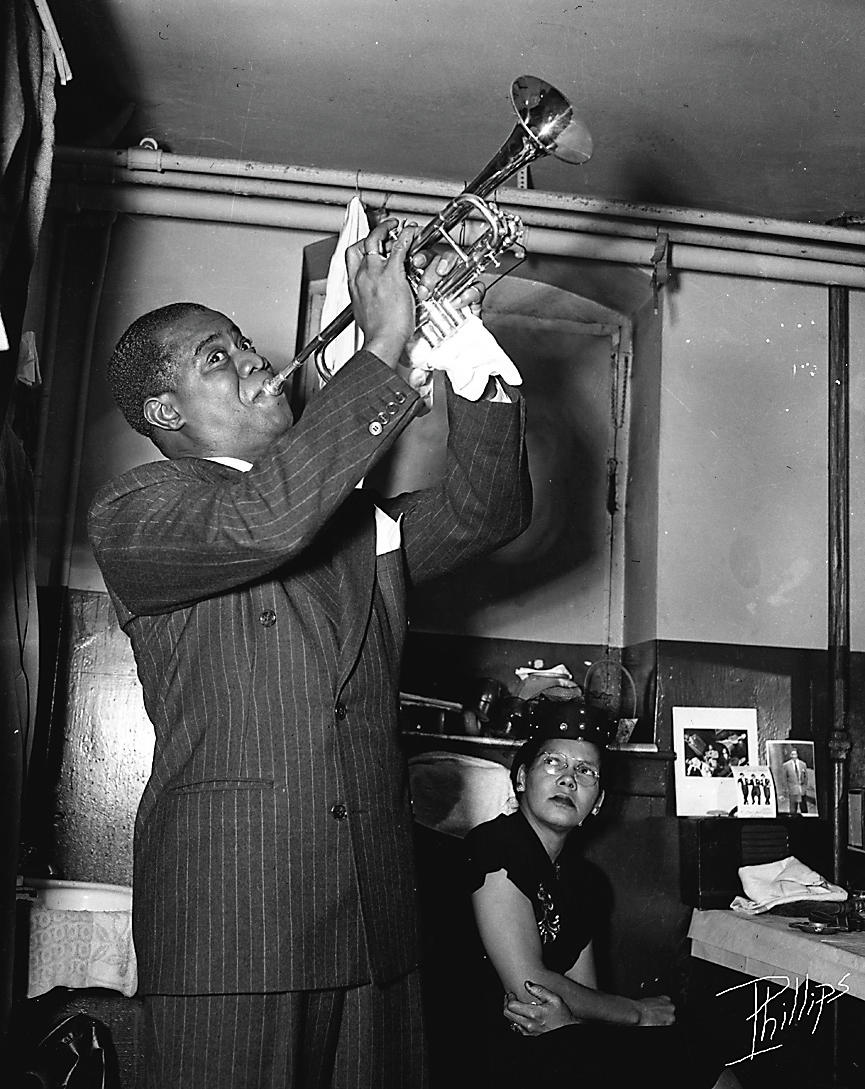
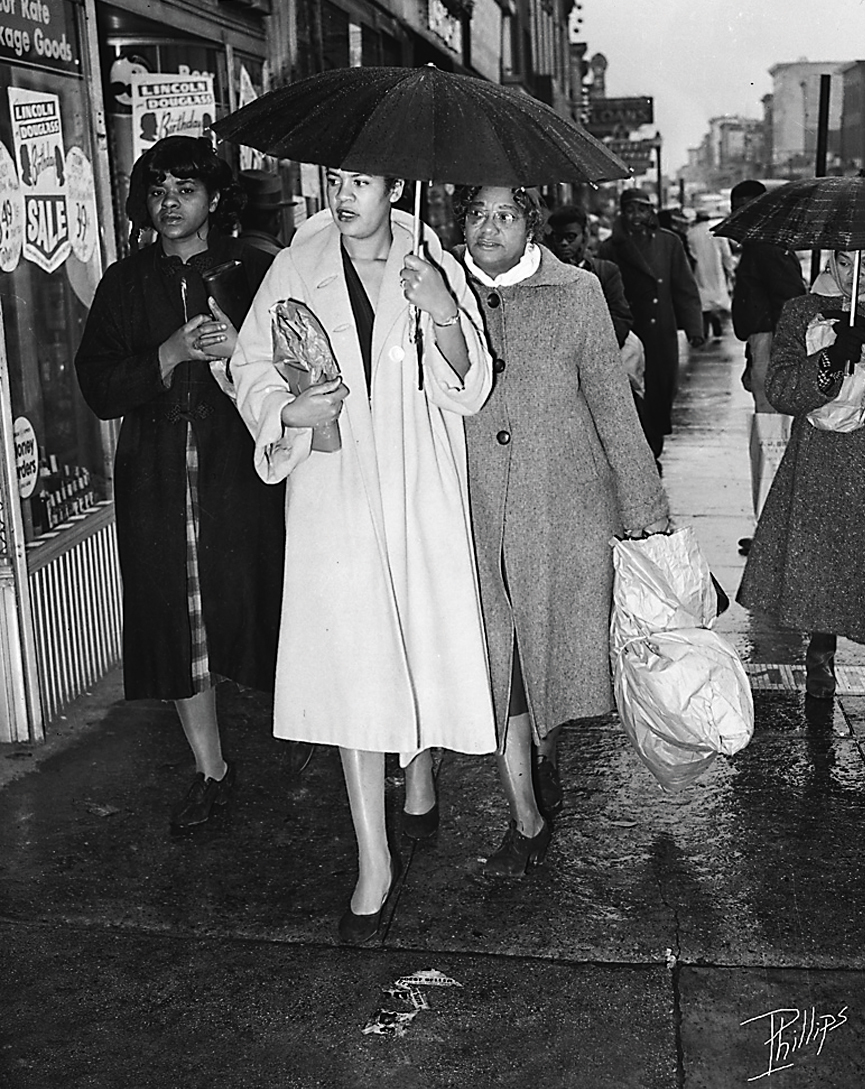
Louis Armstrong backstage in the 1940s at the Royal Theatre; Billie Holiday shopping on Pennsylvania Avenue, early 1950s.
One of those early Great Migration Baltimore families with Chesapeake roots is pictured on the cover of this issue. The proud dad and city postal worker at the far left of the photograph, Walter Dean Sr., had family in Dorchester County. His father left in search of employment shortly after the start of the Great Migration and met his future wife in Baltimore. Alongside Dean Sr. in the full photo (see table of contents) by photographer Henry Phillips—whose own family descended from Southern Maryland, Virginia, and Florida migrants—are his wife, Ruth, and seven of their nine children. The two oldest sons, including civil rights leader and state delegate Walter Dean Jr., were grown and serving in the Air Force by the time the image, which appeared in the Afro-American on March 31, 1956, was taken. It depicts the family after a shopping trip for Easter shoes.
“In that photograph are my grandfather and grandmother, my aunts, one of my uncles, and my mother—she is the second to last from the right,” says Monica Bland, who runs a local business. “In fact, everyone in that photo is alive today, other than my grandparents. My great-grandmother’s family was from the same Church Creek area as Harriet Tubman, about six miles outside Cambridge, and we grew up driving back there on Memorial Day to visit family. I was young, but I remember going to church, the country food and the cookouts, and most of all that we’d stop at Dairy Queen on the way back. My great-grandfather, who was born in 1885, died in 1963, three years before I was born. He’d come to Baltimore to work as a young man and eventually got a job at Bethlehem Steel and worked there a long time. Everyone in that picture made it to the middle class.”
In the ensuing decades, as post-war industrialization shifted into high gear, thousands of others fled from Virginia, the Carolinas, Georgia, and Florida to Baltimore (and the rest of the cities in the northeast corridor), typically on the most direct roads, rails, and bus lines available. In similar fashion, Alabamians, Mississippians, Tennesseans, and Arkansans generally headed due north for the Midwest, while Louisianans and Texans went west for California.
They were leaving behind childhood homes and close-knit families in an age before rural electrification was complete and every house had a telephone, which made the distance between a South Carolina farm and an East or West Baltimore rowhouse feel much greater than today. As with the German, Eastern European, and Jewish immigrants who had arrived at the piers at Locust Point a generation or three earlier, Southern migrants tended to be mostly young, healthy, resilient adults. But as anyone from Baltimore knows, those Southern bonds remain deeply embedded to this day, and city parks are filled each summer with cookouts as Southern family members come up for reunions. And each summer, of course, Baltimore families also trek back to Virginia and the Carolinas to reconnect with relatives who never left.
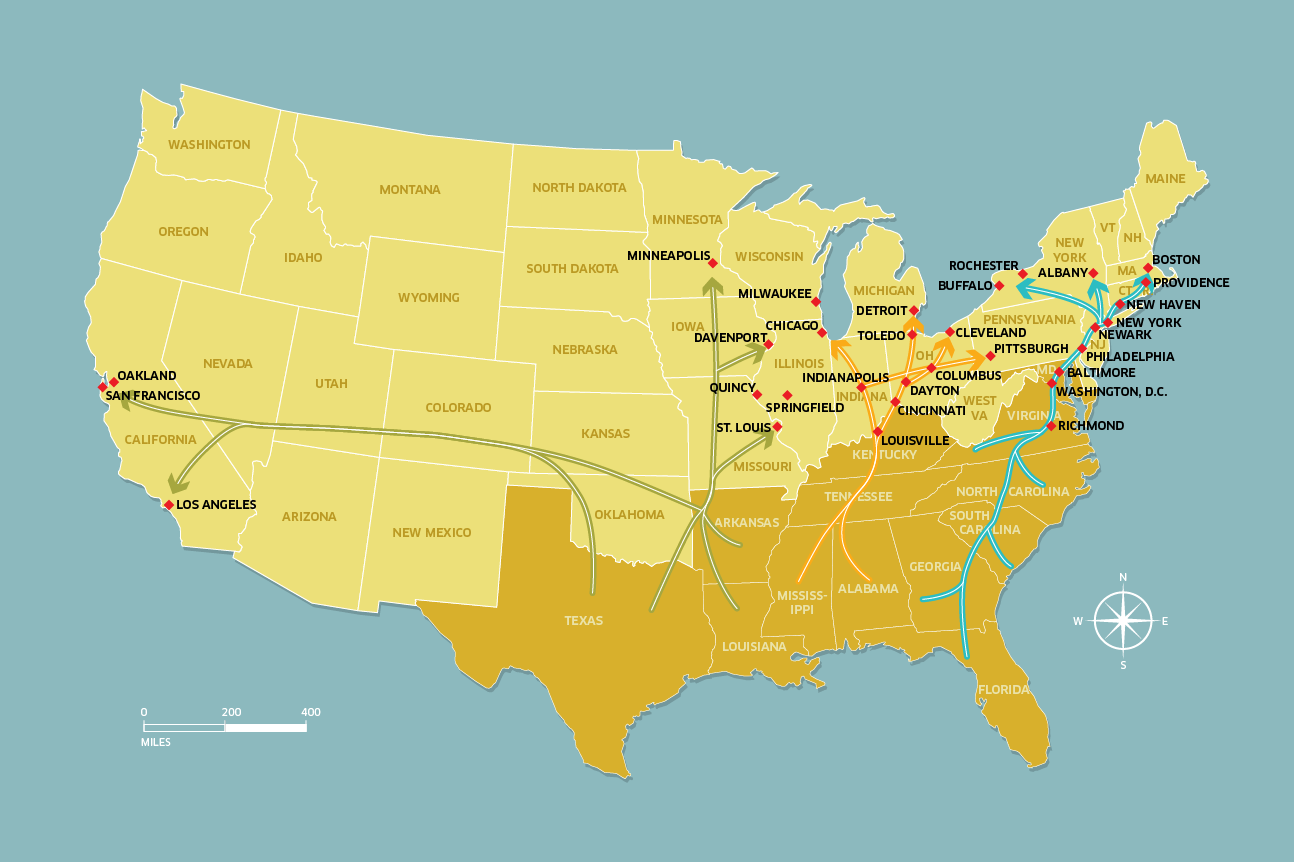

MAP OF THE GREAT MIGRATION
From 1910-1970, more than 6 Million African Americans left the Southern United States for the Northeast, Midwest, and west. AFRICAN AMERICANS MIGRATED TO ESCAPE RACISM, the threat of violence, AND TO SEEK JOBS and educational opportunities IN INDUSTRIAL CITIES.
Those visits are enjoyable, obviously, but sometimes complicated as well. Loyola University professor Kaye Whitehead spent the past holiday season visiting her childhood home in South Carolina with her parents, husband, and college-student son. It was a trip that included stops at her grandparents’ and great-grandparents’ gravesites and a journey filled with smiles, hugs, and love, but also recollections of cruel history and tears. “My son is starting to understand that he is a descendant of men and women who chose to survive,” Whitehead wrote in a series of Facebook posts documenting the trip. “My prayer is that he never forgets.”
In doing research for his memoir, Johns Hopkins University professor Lawrence Jackson, a West Baltimore native and author of My Father’s Name: A Black Virginia Family after the Civil War, had trouble simply locating his grandparents’ home in Virginia, which he had visited regularly as a child in the early ’70s. “My grandparents lived in a house that didn’t have indoor plumbing, just outhouses, and I can still remember sitting in the grass near the railroad tracks as a kid, hoping a train would go by,” he recalls. “So many of the landmarks were gone, it was hard to find. Going back also made me think about the erasure of Black history that has taken place.”
For Baltimore City Office of Civil Rights spokesman John Wesley, born in 1948 in Mississippi, contradictions and complex feelings around family and birthplace are forever intertwined. Wesley grew up on a farm across the street from the white men who beat, shot, and threw the body of Emmett Till in the Tallahatchie River after the 14-year-old Chicago teenager—visiting family over the summer—was accused of offending a white woman in a grocery store. Medgar Evers, the state’s field secretary for the NAACP, killed in 1963, was a family friend. “Before the Civil Rights Act of 1964, there was nothing you could do about anything in Mississippi, whether it was getting a fair trial or getting fair wages,” Wesley says. “You’d get paid $2.50 for picking 100 pounds of cotton. Do you know how long it takes to pick 100 pounds of cotton? All day.”
Wesley’s godmother was the legendary civil rights activist Fannie Lou Hamer. He arrived in Baltimore after landing a job at WJZ-TV in 1973. “Those things you grow up with, you never forget, that’s for better and worse,” Wesley says. “That includes the land, culture, taking your time with people, the food—the pigs’ feet, pigs’ tail, pigs’ ears that we grew up eating, and rabbit and rabbit gravy, too. And you remember the fig trees and pecan trees and fields where you worked, and where your parents and grandparents worked. There was a concrete bench that was in front of my godmother’s house that is still there. My favorite pecan tree is still there, too. It’s still home.”
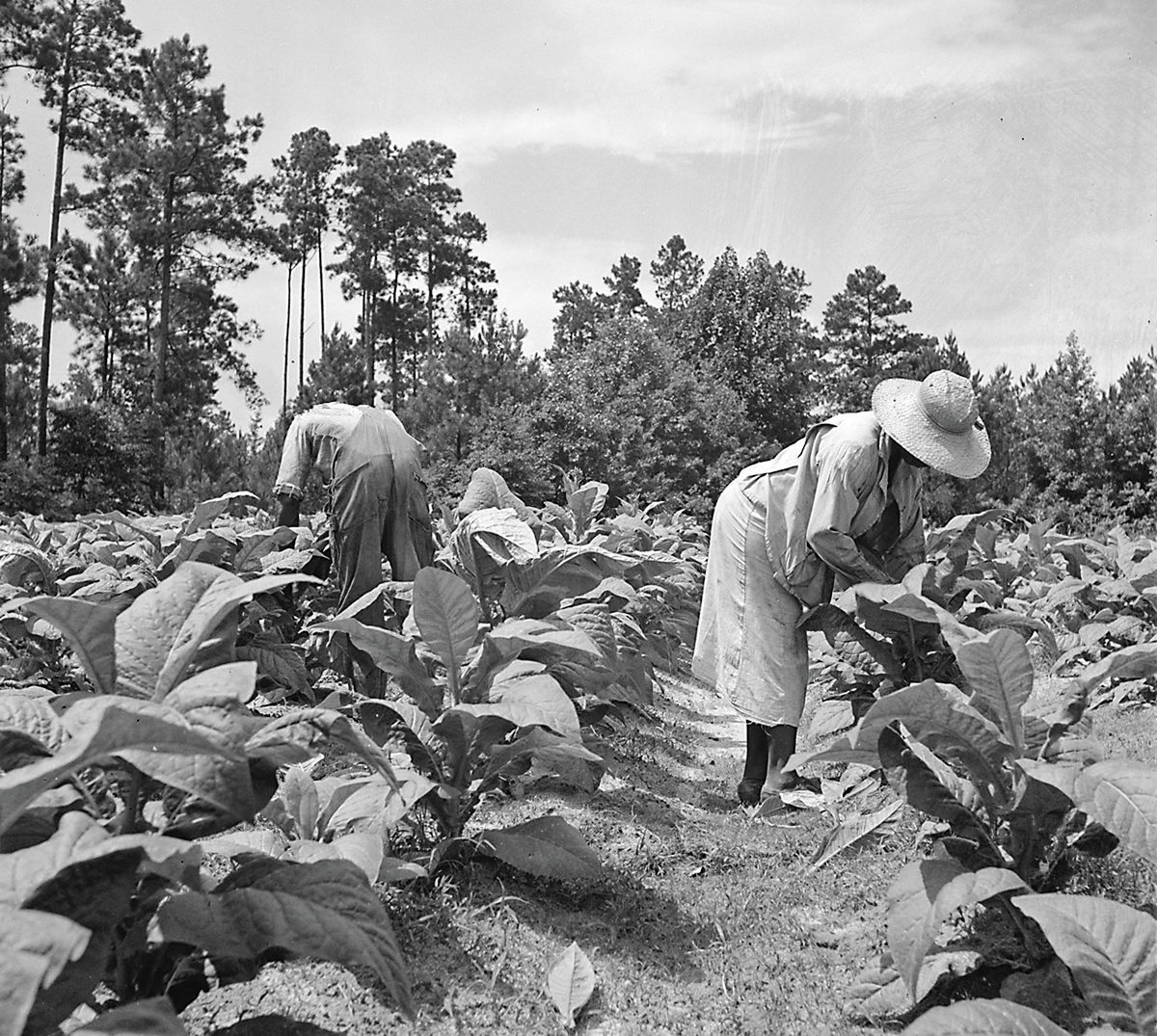
Black tenant farmers tending and pruning tobacco plants, Granville County, North Carolina, July 1939.
If the labor of those migrating from the Deep South was welcome in the factories and mills of Baltimore, and in the kitchens and homes of white families here and in other cities above the Mason-Dixon line, the people themselves often were not. The flip side of the Great Migration is, of course, Jim Crow. “They are inseparable,” says David Taft Terry, former executive director of the Reginald F. Lewis Museum and author of The Struggle and the Urban South: Confronting Jim Crow in Baltimore before the Movement.
Jim Crow, the apartheid system legalized by the 1896 Plessy v. Ferguson decision that made “separate but equal” the law of the land, may have driven African Americans from the Deep South, but it also still plagued migrants whatever their destination, maybe more in Baltimore than any other Great Migration harbor. The broader white population here, and elsewhere, certainly did not take up the cause of desegregation and anti-racism at any time during the Great Migration. The white business community was all too happy to exploit cheap labor while also using the threat of Black replacements to keep white blue-collar workers in line. White political leaders in Maryland and other places, pandering to whites both established and arriving from the rural South for those same manufacturing jobs, often proved all too eager to fan the flames of “fear” for votes. It is no mere coincidence that Baltimore’s extraordinary, first-of-its-kind residential segregation ordinances, later copied in other American cities, as well as apartheid South Africa, were written into law in 1910, just as the Great Migration, coined “the Negro Invasion” by the Baltimore Sun, was getting underway.
Baltimore’s mandate that Black individuals could only move into majority Black blocks, and white people could only move into majority white blocks, was ultimately shot down by the U.S. Supreme Court. But those restrictions were soon replaced with equally efficient redlining and blockbusting practices, as well as private racial housing covenants. Black individuals and families coming to Baltimore not only had to deal with second-class social status, but often substandard alley house and public housing conditions and always a “Colored” school system that received a fraction of the taxpayer support of white schools. The racist housing, workplace, public accommodation, recreation, shopping, and theater practices—not to mention planning that promoted “slum clearance” and urban highway projects that cut through Black neighborhoods—remained intact well into the 1960s. Other Jim Crow policies and practices, like the War on Drugs and disinvestment of Black neighborhoods, the acceptance of police brutality by the city police department, and chronic underfunding of the city’s majority Black public-school system and the city’s historically Black colleges, to name a few, remain in place.
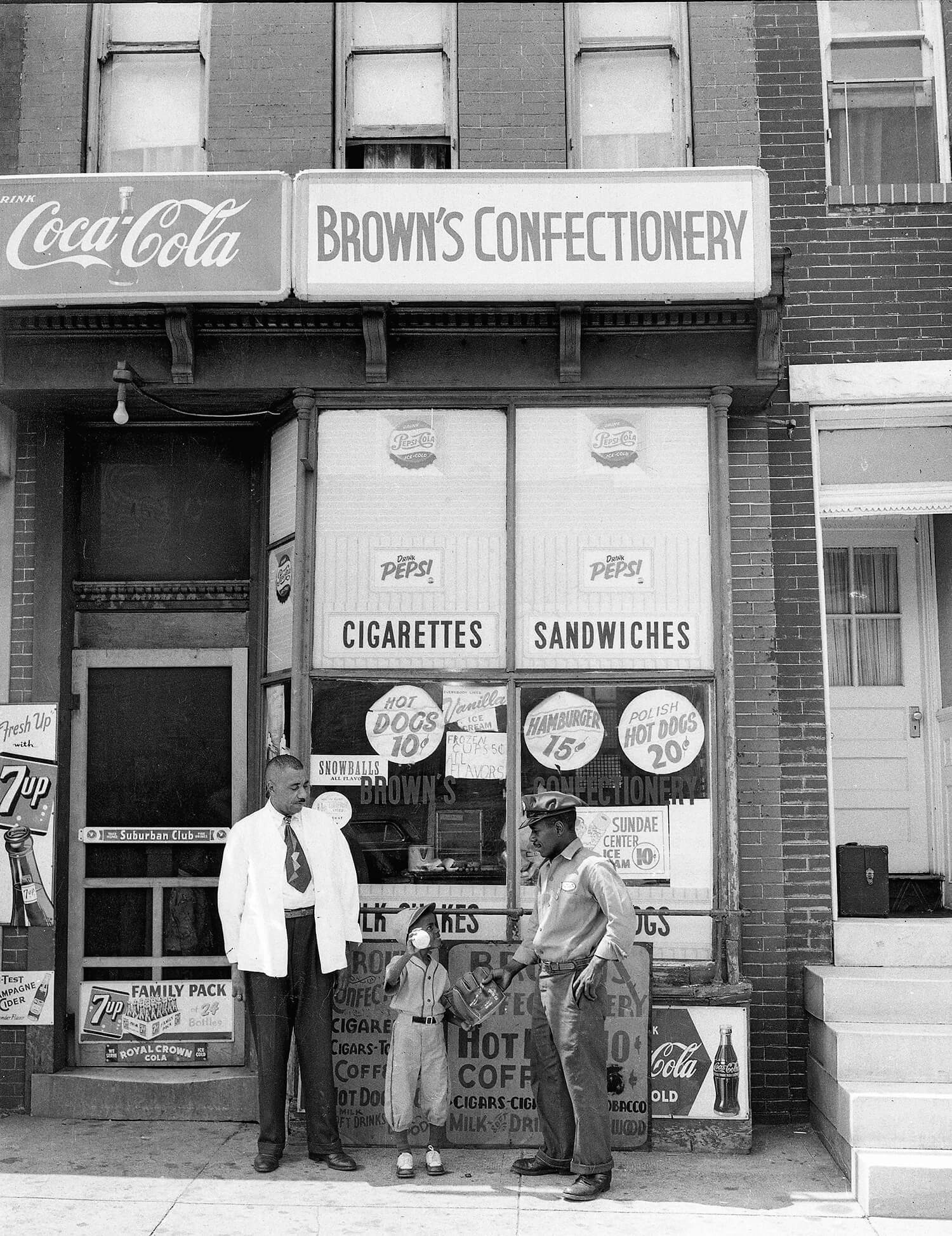
Young Baltimore baseball player shows off his new baseball and mitt in front of Brown’s Confectionery.
Jim Crow laws, in other words, were established to do more than prevent contact between Black people and white people. The intention was to portray white people as superior, but for a larger purpose—the mendacious social construction was (and still is) easily exploited for the purpose of maintaining economic and political power. In Baltimore, Jim Crow rules were clear to those who grew up in the city, if not always clear to outsiders. “Baltimore was always different,” says University of Maryland law professor and Young Thurgood author Larry Gibson, 77. “The assumption is it’s because it is situated in a border state, but the fact is, you have these very different regions within Maryland—the Eastern Shore and Southern Maryland, which are more like the Deep South, and Anne Arundel County, Howard County, Carroll County, and Western Maryland, too. They all surround Baltimore, and the influence is profound. I went to Howard University, and we used to say then that Baltimore was south of D.C. You could eat at more places in Washington. Go out and do things more freely. The strange thing was that in Baltimore, you didn’t see the ‘Colored’ or ‘White Only’ signs on everything like you did further South,” Gibson continues. “Those signs are not even in the photographs of Baltimore of the time. I don’t know why, but you just knew growing up in Baltimore where you could go and where you couldn’t—what park you could go to and what restaurant you could go to—and the ones you can’t. For some reason, no one had to tell you, that’s how ingrained it was.”
Gibson’s mother migrated to Baltimore from St. Mary’s County tobacco country, where he still has many close family members and first cousins. His father’s family is from North Carolina. Like many children of the Great Migration, he enjoyed visits with his maternal-side relatives, to fish and spend time outdoors in the countryside. In many ways, the modern civil rights movement begins in Baltimore. That’s in large part because of the significant free Black community that long existed in the city, and a number of uncommon individuals with pre-Great Migration roots in Baltimore, including Rev. Harvey Johnson, who founded the Mutual United Brotherhood of Liberty, predecessor of the NAACP; Carl Murphy, longtime publisher of the Afro-American; Thurgood Marshall, the first head of the NAACP Legal Defense Fund and first Black justice to sit on the Supreme Court; Lillie Carroll Jackson, the head of the Baltimore chapter of the NAACP from 1935-1970; and her daughter Juanita Jackson Mitchell and her husband Clarence Mitchell Jr.
Motivated by the lynching of George Armwood in Princess Anne County in 1933, Marshall, 19 months after passing the bar, took up the case of Amherst College graduate Donald Murray and successfully challenged the University of Maryland law school’s policy of not admitting Black applicants. In 1950, Marshall won another key victory on the road to his Brown v. the Board of Education victory four years later when he took up the case of aspiring Baltimore nurse Esther McCready, who had challenged the University of Maryland nursing school’s policy of not admitting Black students.
Meanwhile, the city’s burgeoning Black population augmented the budding mid-century civil rights protest movement in Baltimore. Morgan State’s growing student body provided strength-in-numbers support for the long picket at Ford’s Theatre in the 1940s and 1950s, and sit-ins at Read’s Drug Stores, the Northwood movie theater, White Coffee Pot restaurants, and Arundel Ice Cream shops over the next two decades. Hundreds of people were arrested at the segregation protests at the Gwynn Oak Amusement Park in 1963. Having already come so far, often it was young Black migrants from the South who put their bodies on the line to challenge Jim Crow in Baltimore.
In 1960, Dunbar High junior Robert Bell, future chief judge of Maryland’s highest court, took part in a sit-in protest at Hooper’s Restaurant that led to a case that reached the Supreme Court. “In North Carolina, where I was from, there was just a small town, so everything was segregated. You sat in the balcony at the movie theater, went to the back door at the restaurant to get served,” Bell recalls during a break at a recent Maryland Lynching Memorial Project symposium at the Morgan State Center for Civil Rights in Education, which is named after him. “In East Baltimore, though, where my mother moved us before I started school, we had a Black theater in the neighborhood where you could sit anywhere you like. We had Black restaurants. You could shop on Gay Street and try on and buy all your clothes and shoes. But then, if you went downtown, the rules were totally different. Somehow that made it all the more crazy, more striking. College students from Morgan had come to Dunbar to recruit student volunteers for a sit-in, and it wasn’t hard to persuade me to go along.”
Jim Crow | In Maryland
Thomas Dartmouth Rice, a white American actor, gained wide popularity performing in blackface as “Jim Crow,” a hapless, exaggerated, highly distorted black character who sang “Negro ditties.” By the late 1830s, the term “Jim Crow” had become a racial epithet for blacks, with Rice’s traveling minstrel shows aiding the spread of Jim Crow as a slur. By the turn of the 19th century, Jim Crow was in use to describe codified laws and practices that segregated and oppressed blacks in the South and North.
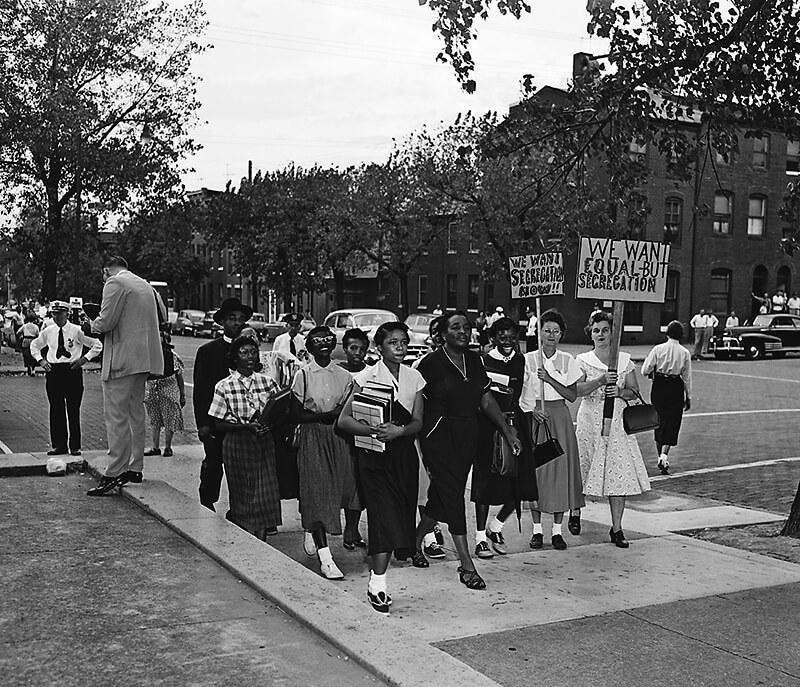
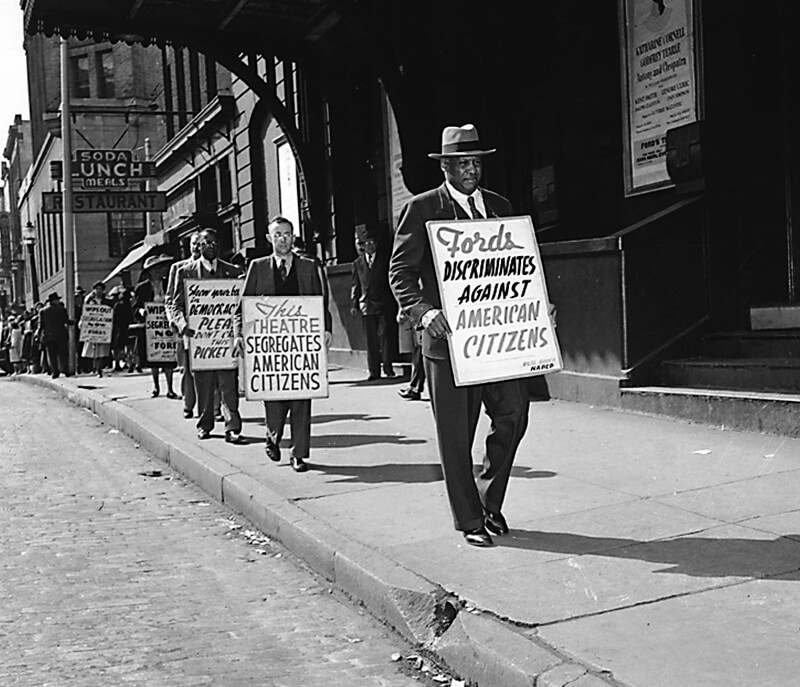
(Top) Reverend James L. Johnson escorts students past two demonstrators protesting the desegregation of Baltimore schools. Some 2,000 white teenagers marched across the city, Oct. 4, 1954. (Bottom) Paul Robeson (front) picketing Ford's Theatre Jim Crow admission policy, March 1948.
1870: Maryland rejects the ratified 15th Amendment guaranteeing voting rights to African Americans.
1884: Interracial marriages banned in Maryland.
1891: The University of Maryland School of Law in Baltimore bans African Americans from attending.
1904: Public transportation and other public facilities in Maryland are segregated by law.
1906-9: Edd Watson, Henry Davis, James Reed, William Burns, and William Ramsay are lynched on Maryland's Eastern Shore.
1910: Baltimore enacts the nation’s first housing ordinance segregating neighborhoods by blocks.
1911: King Johnson is lynched in Anne Arundel County.
1913: NAACP chapter established in Baltimore.
1915: Chapter 51 of the Ku Klux Klan (KKK) is formed in Mount Rainier.
1922: KKK rallies in Baltimore and Frederick.
1924:Maryland passes a law punishing “any white woman who shall suffer or permit herself to be got with child by a Negro or mulatto . . . to the penitentiary for not less than 18 months.”
1931:A white mob lynches Matthew Williams in Salisbury.
1933: George Armwood is lynched in Princess Anne.
1942: Baltimore police officer kills an unarmed Black soldier, Pvt. Thomas Broadus, setting off police brutality and discrimination protests in the state.
1947: Baltimore’s NAACP branch begins a five-year, ultimately successful, picket of Ford’s Theatre.
1948: 24 Black and white tennis players are arrested while playing together on Druid Hill Park’s “whites-only” courts.
1954: Baltimore public schools desegregate following landmark Brown v. Board of Education decision; Anne Arundel and Howard counties will take more than a decade to comply.
1955: Morgan State students and the Committee on Racial Equality (CORE) organize historic sit-in protests and desegregate Read’s lunch counters.
1959: 90 years after the 14th Amendment guaranteeing full civil rights to African Americans is adopted, Maryland finally ratifies the amendment.
1960: Local high school students, including future Maryland Court of Appeals Chief Judge Robert Bell, then a junior at Dunbar High, demand service at Hooper’s Restaurant at Charles and Fayette Streets in a case that eventually reaches the U.S. Supreme Court.
1960: Morgan State students are arrested at Hecht-May Co. department store in the Northwood Shopping Center.
1963: Nearly 350 Morgan State students are arrested protesting segregation at the Northwood movie theater.
1963: July 4 and 7, nearly 400 demonstrators are arrested while protesting segregation at Gwynn Oak Amusement Park.
1963: Racial tensions rise in Cambridge after pro-segregation police and white citizens attack Black students attempting to get served at the Dizzyland restaurant.
1966: KKK cross-burnings in Camp Springs.
1967: Over Easter weekend, three crosses are burned in Laurel.
1972: Alabama Gov. George Wallace, a segregationist, wins state Democratic primary.
2017: Baltimore City removes four Confederate monuments.
Even before that, in the summer of 1944, a decade before Rosa Parks refused to move to the back of the bus in Montgomery, Alabama, a young Baltimore mother with two children named Irene Morgan, who built B-26 bombers at the Glenn L. Martin plant by day, refused to give up her seat on a Greyhound bus after visiting her mother back home in Gloucester County, Virginia. Morgan’s husband worked on Baltimore’s docks, and she was returning to the city after an extended stay with her mother while recovering from a miscarriage. When the bus grew crowded and the Greyhound driver demanded she give her seat to a white couple, Morgan refused. When a sheriff’s deputy at the jail, where the driver drove when she wouldn’t budge, tried to pull her off, Morgan resisted and spent seven hours in county lock-up.
She paid the $100 fine for resisting arrest, but she refused to pay the $10 fine for violating a Virginia law requiring segregated seating in public transportation. Morgan, who died in 2007, was driven, as a family member explained, by “the pent-up bitterness of years of seeing the Colored people pushed around,” and she accepted the burden of bearing witness in court. The NAACP and Marshall took up her cause and won a landmark desegregation victory regarding interstate transportation in 1946.
A year after the decision, white and Black activists with the newly formed Congress of Racial Equality launched a two-week “Journey of Reconciliation” through the South to explain and test the Morgan decision. On buses and trains, they sang a song penned by organizers called “You Don’t Have to Ride Jim Crow!”
On June the Third the high court said, When you ride interstate, Jim Crow is dead. . . . Get on the bus, sit anyplace, ’Cause Irene Morgan won her case. You don’t have to ride Jim Crow.
In the ensuing years, Morgan would remarry and move to New York, where she ran a childcare business. At 68, she earned a bachelor’s degree from St. John’s University. In her 70s, she received a master’s degree in urban studies.
“[The deputy sheriff] put his hand on me to arrest me, so I took my foot and kicked him,” recounted Morgan, who returned to Virginia to live out her final years, a half-century later in a PBS documentary. “He was blue and purple and turned all colors. I started to bite him, but he looked dirty, so I couldn’t bite him. So all I could do was claw and tear his clothes.
“That was a seat I had paid for,” she said. “Sometimes, you are so enraged, you don’t have time to be afraid.”
ORAL HISTORIES
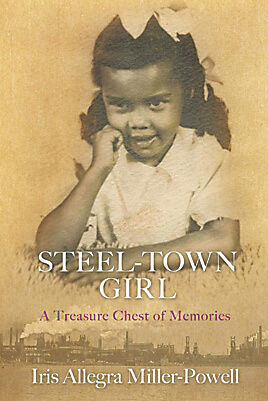
iris allegra miller-powell
the Steel-Town Girl author's family migrated from Virginia to Baltimore after her father, Percy Davis Miller, landed a job at Bethlehem Steel in the 1940s.
My mother was pregnant with me upon our arrival at 613 I Street in Sparrows Point in 1949. In order to live in the company houses, as we did, the head of the household had to work for the company. There was myself, my brothers Emile, Gerald, Chauncey, and, later to come, our baby sister, Leatrice, living there. Our oldest brother, Reggie, lived in Virginia with our grandparents, but stayed with us in the summer. Our older sisters, Eleanor, Jenny, and Curley, were grown by then. One early memory was when I was invited across the street to Ms. Pearl Boware’s house for a soft candy peppermint stick pushed down into a juicy lemon.
People on the “white” side lived on C through H streets, and we on the “Colored” side lived on I, J, and K streets. Although we were free to walk or ride over to “the other side” as it was called, we just took care of our business at the white-owned establishments [restaurants, grocery, department, and drug stores]. We didn’t linger when we finished—we headed right back over to “our” side. I went to an all-Black school until ninth grade. Our family used to go down to Virginia to visit my grandparents in the summertime, and I remember being shocked at the end of one summer that my cousins in Virginia weren’t going to school that year. They had closed the school rather than desegregate.
There was still farming going on down there [on my grandparents’ land], and my father always kept a big vegetable garden—tomatoes, corn, cucumbers, potatoes, onions, greens, string beans, collards—across the street from our house, too. He brought the country with us to Sparrows Point. One particular time, we found ourselves with a feathered friend . . . a brown hen that was brought back as a pet.
My dad was very proud when I had gotten a job at the main office of Bethlehem Steel—I was the second Black person to work in the purchasing department. My brothers Gerald and Chauncey worked at Bethlehem Steel, too. Daddy liked to visit “Mickey’s” after work, where he could unwind with his friends. Then, he would drive home and have a delicious meal, which my mother had prepared. He always said grace. And when Sunday came, he dressed in a suit and tie to go to church with the rest of our family. Daddy served as an usher, dutifully, for as long as I can remember. He was a sincere man with a love for Christ. As a boy in Virginia, he worked on his parent’s farm and only had a third-grade education [but] he was highly intelligent. He would memorize scripture, not wanting people to know he couldn’t read sufficiently. He found a way to keep that to himself. When he was to participate by “reading” from the Bible during a special program, he simply walked to the rostrum, opened his Bible to his favorite scripture, Psalm 133, and “read” it from his memory. —Edited from Steel-Town Girl and 2019 interview.
MOSES NEWSON
The 93-year-old Florida Native covered the civil rights movement for the Afro-American.
The South was always pretty tough, places like Mississippi were just backwards, racially speaking. And we got this real hateful climate where people in the Congress and other leaders were speaking forcefully about the fact that they were not going to integrate schools. George Lee was killed for trying to get Black folks to register to vote. He was actually one of two people who were killed in 1954 there, just before in 1955 Emmett Till was killed. You went out there to do a job. Most of us thought that it was important.
Shortly after that, we were [in Atlanta with] the Freedom Riders. Martin Luther King told our good friend Simeon Booker [the first Black journalist at The Washington Post] that the KKK and others were planning to see that the Freedom Riders never got out of Alabama alive. I was on the Greyhound, and they threw this firebomb thing in the seat just behind me, which was an empty seat.
I got a few burns on the back of the ear and that sort of thing, but nothing serious. Suddenly, it was pitch black on that bus. And I said, “Well, I’m going to be the last guy off this bus. Nobody gets trapped on here.” So, I just put a handkerchief over my mouth and nose and hung around as long as I could. I tell you, when you stepped off that bus and you looked around and saw these people crawling around, trying to get the smoke out of their chest, and people crawling and coughing and gagging, it was one of those sights that makes you wonder why Americans are doing that sort of thing to fellow Americans who were just trying to exercise their rights. Eventually, that bus burned right down, broad open daylight. —Edited from a Library of Congress oral history, 2011.
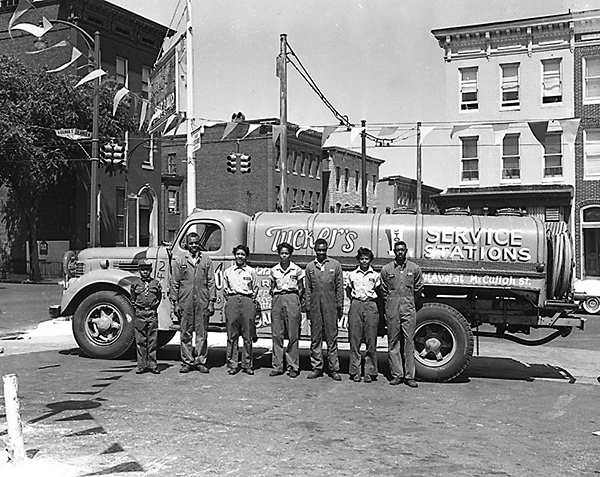
IRV TUCKER
son of a Baltimore veteran and service station operator, his family migrated from Virginia and Georgia.
That picture was taken at my father’s gas station on the southwest corner of Lafayette Avenue and North Gilmore Street. It was probably 1958. I was 8. My dad was the proprietor of that gas station and a second one located at West North Avenue and McCulloh Street. I remember my dad telling me that he was the first Black—“Colored” in those days—Sinclair station proprietor in Baltimore. He became the proprietor in 1952. The location pictured was a full-service station, offering basic maintenance like oil changes, as well as mechanical repairs and tire service. The station on North Avenue offered gasoline and oil changes only. My dad also had a tow truck in addition to the tank truck in the picture. He used the tanker to deliver heating fuel oil during the cold months. Regarding the photograph, from left to right are me, my dad, and my mom. I do not remember the names of the remaining individuals, but they worked for my dad.
My dad closed the North Avenue location in 1960 and the main location in 1961. He later taught automotive repair in Baltimore City public schools. My dad was the youngest of six children and was born in Baltimore in 1921, but his oldest siblings were born in Virginia. He served in the Army with my mother’s brother, and that’s how [my parents] met. Her family had migrated to Philadelphia from around Griffin, Georgia, in 1919, shortly after her parents married. I was told my grandfather said, “I’m not going to raise my children in the South.”
Both my parents—they married shortly after he returned from World War II, in June 1946—have gone to be with Jesus and are laid to rest at the Maryland Veterans Cemetery at Garrison Forrest. This was my dad’s request. He passed in 1995 in Baltimore. My mother, Eunice, died at 86 in 2011. He was a member of 548th Combat Engineers Company, a segregated all-Black unit, and a motor sergeant, which was as high as you could go. He said several times that he wanted to be “with my boys” when his time came. —Edited from 2019 interview.
ESTHER McCREADY
The 89-year-old Dunbar High Graduate Challenged Maryland Nursing School's 'White Only' policy.
From 8 years old, I wanted to be a nurse, and Provident Hospital was the only school in Baltimore because everything else was segregated. All hospitals were segregated. There was nothing wrong with Provident. When I graduated from high school, one of my classmates was admitted there. But I said to another classmate, “It’s a shame we can’t go to any school we want to go to merely because of our race.” I said, “Let’s write to the white schools.” I don’t know where it came from. She said, “You know what they are going to say.” I said, “Yes, but let’s write anyway.” All of this is just coming [out of me].
We started getting replies back: “We don’t accept Negroes.” “We don’t accept Negroes at this time.” Maryland sent me the catalogue that we had requested and the application. When I took my [physical examination] form to my medical doctor, he said, “Did you contact the NAACP? You know you are not going to get in there without their help.” They sent me the application, but he said that doesn’t mean anything. I believe [my physician] contacted the NAACP, because I heard from Donald Murray [who had integrated Maryland's law school]. They wanted me to talk to Charles Houston [the NAACP’s first litigation director], and the first thing he said was, “Who put you up to it?” I told him nobody. He said, “Okay, you’re very brave, and since you started it, we'll let you continue, and if you get into any trouble, call on us.”
Of course, the admission date [came] and I hadn’t heard from them. It was always, “The committee on admissions is reviewing your credentials”—that was their mantra. I called them. That’s when Charles Houston and Donald Gaines Murray went into the lower court to argue. We lost there. Charles Houston had a heart attack by the time the appeal came up, so that’s how Thurgood Marshall got in. He was called down from New York to argue the appeal with Donald Murray, and in April 1950, the decision was handed down that the university had to admit me. And that was another song and dance. I remember that first day when they pretended they had no [dormitory] rooms there and I had to commute. It was so stressful. That first day a nurse had come to me and said, “If you don’t pray to God, you won’t get out of here because nobody here is for you.” And I looked at her and I said, “If God intends for me to get out of here, nobody here can stop me.” Many trials and tribulations, but I did graduate. I still go back to encourage the young people coming in. —Edited from remarks at Maryland Historical Society, 2012.
